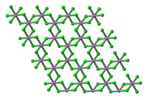Vanadium(III) chloride
| |||
| Names | |||
|---|---|---|---|
| IUPAC names
Vanadium(III) chloride
Vanadium trichloride | |||
| Identifiers | |||
3D model (JSmol)
|
|||
| ChemSpider | |||
| ECHA InfoCard | 100.028.859 | ||
PubChem CID
|
|||
| RTECS number |
| ||
CompTox Dashboard (EPA)
|
|||
| |||
| |||
| Properties | |||
| VCl3 | |||
| Molar mass | 157.30 g/mol | ||
| Appearance | violet crystals paramagnetic | ||
| Density | 3.0 g/cm3 (20 °C) | ||
| Melting point | > 300 °C (572 °F; 573 K) (decomposes) | ||
| soluble | |||
| +3030.0·10−6 cm3/mol | |||
| Structure | |||
| Trigonal, hR24 | |||
| R-3, No. 148 | |||
| Hazards | |||
| Safety data sheet | Vanadium(III) Chloride | ||
| GHS labelling:[1] | |||
 
| |||
Signal word
|
Danger | ||
| H302, H314 | |||
| P280, P305, P310, P338, P351 | |||
| Flash point | Non-flammable | ||
| Related compounds | |||
Other anions
|
vanadium trifluoride, vanadium tribromide | ||
Other cations
|
titanium trichloride, chromium(III) chloride, niobium trichloride, tantalum trichloride | ||
Related compounds
|
vanadium dichloride, vanadium tetrachloride | ||
Except where otherwise noted, data are given for materials in their standard state (at 25 °C [77 °F], 100 kPa). | |||
| Infobox references | |||
Vanadium trichloride is the inorganic compound with the formula VCl3. This purple salt is a common precursor to other vanadium(III) complexes.[2]
Structure[]
VCl3 has the common BiI3 structure, a motif that features hexagonally closest-packed chloride framework with vanadium ions occupying the octahedral holes. VBr3 and VI3 adopt the same structure, but VF3 features a structure more closely related to ReO3. VCl3 is paramagnetic and has two unpaired electrons.
Preparation and reactions[]
VCl3 is prepared by heating VCl4 at 160–170 °C under a flowing stream of inert gas, which sweeps out the Cl2. The bright red liquid converts to a purple solid.
Heating of VCl3 decomposes with volatilization of VCl4, leaving VCl2.[3] Upon heating under H2 at 675 °C (but less than 700 °C), VCl3 reduces to greenish VCl2.
- 2 VCl3 + H2 → 2 VCl2 + 2 HCl
Comproportionation of vanadium trichloride and vanadium(V) oxides gives vanadium oxydichloride:[4]
- V2O5 + VOCl3 + 3 VCl3 → 6 VOCl2
Vanadium trichloride catalyses the pinacol coupling reaction of benzaldehyde (PhCHO) to 1,2-diphenyl-1,2-ethanediol by various reducing metals such as zinc:[5]
- Zn + 2 H2O + 2 PhCHO → (PhCH(OH))2 + Zn(OH)2
Complexes[]
VCl3 forms colorful adducts and derivatives with a broad scale of ligands. VCl3 dissolves in water to give the hexahydrate, but the formula is deceptive. The salt is described by the formula [VCl2(H2O)4]Cl.2H2O. In other words, two of the water molecules are not bound to the vanadium, whose structure resembles the corresponding Fe(III) derivative. Removal of the two bound chloride ligands from [VCl2(H2O)4]+ in aqueous solution gives the green ion [V(H2O)6]3+.[6]

With tetrahydrofuran, VCl3 forms the red/pink complex VCl3(THF)3.[8] Vanadium(III) chloride reacts with acetonitrile to give the green adduct VCl3(MeCN)3. When treated with KCN, VCl3 converts to [V(CN)7]4− (early metals commonly adopt coordination numbers greater than 6 with compact ligands). Complementarily, larger metals can form complexes with rather bulky ligands. This aspect is illustrated by the isolation of VCl3(NMe3)2, containing two bulky NMe3 ligands.
Organometallic derivatives[]
Vanadium(III) chloride as its thf complex is a precursor toV(mesityl)3.[9]
- VCl3(THF)3 + 3 LiC6H2-2,4,6-Me3 → V(C6H2-2,4,6-Me3)3(THF) + 3 LiCl
References[]
- ^ "Vanadium(III) Chloride SDS". American Elements. Retrieved 2018-08-17.
- ^ Holleman, A. F.; Wiberg, E. Inorganic Chemistry Academic Press: San Diego, 2001. ISBN 0-12-352651-5.
- ^ Young, Ralph C.; Smith, Maynard E.; Moeller, Therald; Gordon, Paul G.; McCullough, Fred (2007). "Vanadium(III) Chloride". Inorganic Syntheses. pp. 128–130. doi:10.1002/9780470132357.ch43. ISBN 9780470132357.
- ^ G. Brauer (1963). "Vanadium Oxydichloride". In G. Brauer (ed.). Handbook of Preparative Inorganic Chemistry, 2nd Ed. NY: Academic Press. p. 1263.
- ^ Xu; Hirao, Toshikazu (2005). "Vanadium-Catalyzed Pinacol Coupling Reaction in Water". The Journal of Organic Chemistry. 70 (21): 8594–8596. doi:10.1021/jo051213f. PMID 16209617.
- ^ Donovan, William F.; Smith, Peter W. (1975). "Crystal and Molecular Structures of Aquahalogenovanadium(III) Complexes. Part I. X-Ray Crystal Structure of trans-Tetrakisaquadibromo-Vanadium(III) Bromide Dihydrate and the Isomorphous Chloro- Compound". Journal of the Chemical Society, Dalton Transactions (10): 894. doi:10.1039/DT9750000894.
- ^ Albert Cotton, F.; Duraj, Stan A.; Powell, Gregory L.; Roth, Wieslaw J. (1986). "Comparative Structural Studies of the First Row Early Transition Metal(III) Chloride Tetrahydrofuran Solvates". Inorganica Chimica Acta. 113: 81. doi:10.1016/S0020-1693(00)86863-2.
- ^ Manzer, L. E. (1982). Tetrahydrofuran Complexes of Selected Early Transition Metals. Inorganic Syntheses. 21. pp. 135–140. doi:10.1002/9780470132524.ch31.
- ^ Vivanco, Marilin; Ruiz, Javier; Floriani, Carlo; Chiesi-Villa, Angiola; Rizzoli, Corrado (1993). "Chemistry of the vanadium-carbon .sigma. Bond. 2. Oxovanadium(IV) and oxovanadium(V) containing metal-to-carbon .sigma. Bonds". Organometallics. 12 (5): 1802–1810. doi:10.1021/om00029a042.
- Vanadium compounds
- Chlorides
- Metal halides

